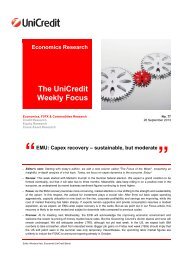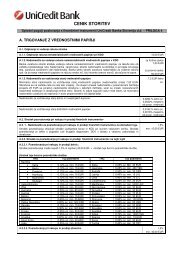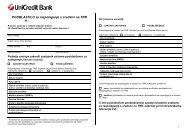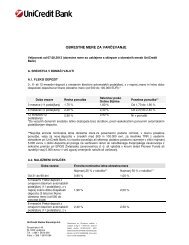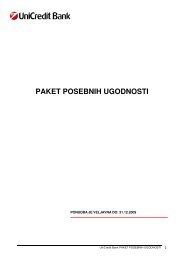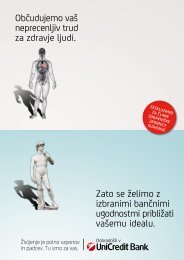Letno poroÄilo 2009.pdf - UniCredit Banka Slovenija dd
Letno poroÄilo 2009.pdf - UniCredit Banka Slovenija dd
Letno poroÄilo 2009.pdf - UniCredit Banka Slovenija dd
- No tags were found...
You also want an ePaper? Increase the reach of your titles
YUMPU automatically turns print PDFs into web optimized ePapers that Google loves.
IntroductionStatement by the Chairman of the Management BoardDespite significantly changed an<strong>dd</strong>eteriorated business conditions,compared to other financialintermediaries, the Bank is satisfiedwith the results it achieved.Dear ladies and gentlemen, respected business partners,The 2009 developments in the home market, as well as in the globalmarket, were marked by economic crisis, which caused a substantialchange in economic conditions and which also had a fundamentalimpact on overall results. If 2008 saw most of our focus on highinflation levels and their impact on our edge in foreign markets, 2009was marked particularly by the significant drop in gross domesticproduct (GDP), which fell from 3.5 % in 2008 to -7 % in 2009.What are the most important factors for such low economic growth,rising unemployment, high budget deficit, and decreased nationalconsumption?• The Slovenian economy, in its openness, depends heavily onforeign markets, especially those within the EU but also onindividual, fast growing economies. Demand on these markets wasreduced significantly, resulting in a drop in Slovenian exports ofapproximately 20 % and simultaneously a drop in imports of morethan 23 %. Consequently, the country recorded an equilibriumof the balance of payments, which is an important achievementcompared to the previous year, when there was a deficit ofapproximately 6 % of the GDP.• A very sharp fall of more than 20 % was registered withinvestments into fixed assets. It should be emphasized that thiscategory exceeded 30 % of the GDP in the past few years and wasa generator of growth for the Slovenian economy and, at the sametime, a guarantor for a high employment rate. It has to be a<strong>dd</strong>edthat the Slovenian as well as foreign credit support to investmentsused to be on a very high level. In other words, credit growth ofthe Slovenian banking system in the amount of 38 % on an annualbasis peaked in 2007 and exceeded 20 % even in 2008, while itmore or less halted in 2009. It is due to this fact that the Slovenianeconomy differs substantially from those of its rival countries,where credit growth was not so intensive, even though everywhere,including the old members of the European Monetary Union, creditgrowth substantially exceeded the values planned. What we wishto underline is the fact that rival economies are nearly as open forinternational trade as the Slovenian economy and yet they did notexperience such a fall of the GDP and international trade. Highcredit growth, which Slovenia has been recording since it becamea member of the EU in 2004, fostered, on one hand, quick growthof various investments while on the other, also affected greaterdomestic demand and substantially higher price growth comparedto other members of the European Monetary Union.• In such conditions, domestic demand began to shrink with arecorded drop of over 4 %. On the other hand, public consumptionrecorded a 3.2 % growth.120 2009 Annual Report · <strong>UniCredit</strong> Bank



